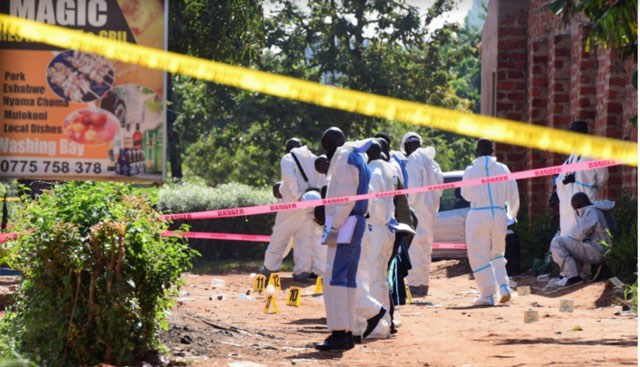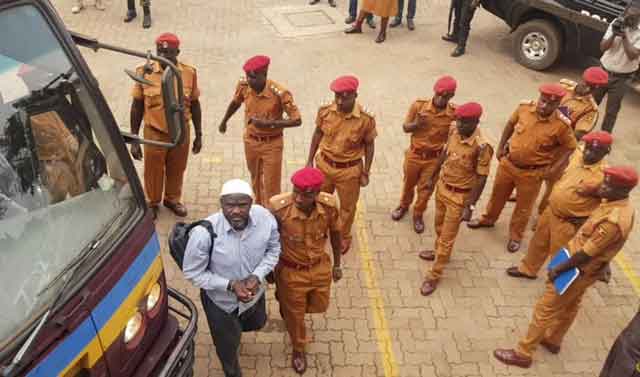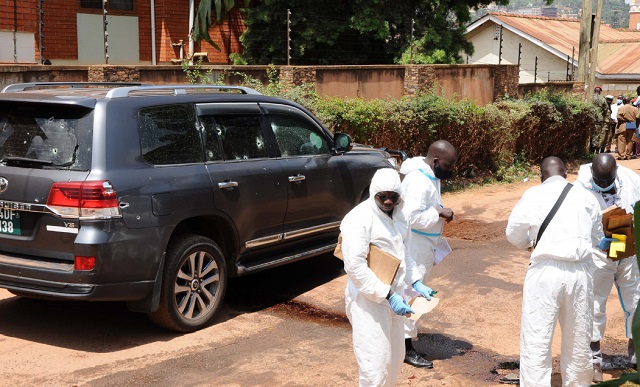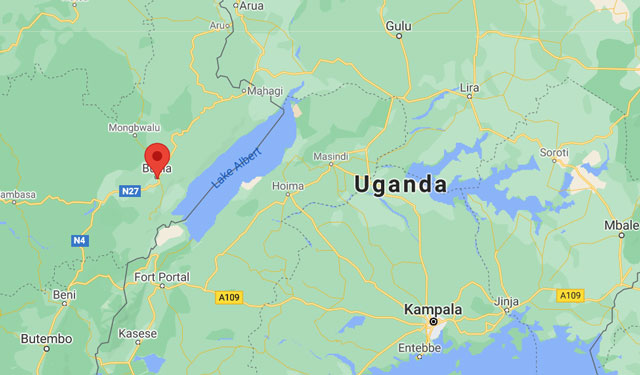Days after he reportedly blew himself up on a bus full of passengers headed to western Uganda from Kampala city, little is still known about Isaac Matovu; a 23-year old youth.
The police say he has been a resident of Kamuli A Zone, a high population and low-income suburb of Kampala city. But local leaders there say no resident has come up to identify the photo police has circulated.
Failure of residents to identify a person who turns out to be a terrorist is not unusual. Many are aloof, like to lie low, and avoid being noticed. Some already have criminal records and engage in activities such as robberies to raise money. Many wander outside only after dark.
But the Matovu case might point at a bigger problem for the police. There is high likelihood that many people doubt what the police say.
The case is similar to another death related to the recent bombings. This time it concerns one of the victims of the bombing; Emily Nyinaneza.
Nyinaneza, a waiter who is suspected to be about 20 years old died when the bomb in the pork eatery hit her. But residents were surprised that no relative came up to claim her body. She was buried in a public burial ground run by the city in a ceremony attended by friends and acquaintances. Unlike Matovu, Nyinaneza was known to many people in the neighbourhood where she worked. But none of them knew her story, it appears. It that sense, she is really no different from Matovu. Both young people apparently involved in daily hustle. And that is the problem for President Yoweri Museveni and his people who are attempting to nip terrorism in the bud.
Two apparently home-made Improvised Explosive Devices (IEDs) popping just two days apart have raised the spectre of domestic terrorism and placed the country on heightened alert.
A statement by Police Spokesperson Fred Enanga on Oct. 26 suggested that the explosions were the handiwork of the same group of people.
“We have established from the hallmarks of the attack and the bomb materials recovered, a connection with the attack that occurred 3 days ago in Komamboga, suggesting that the IEDs, could have been prepared in one place or by the same group of attackers.”

Enanga added, “This, therefore, implies that the attackers are using different strategies of suicide vests and belts, armed assailants on bodabodas or motorcycles, physical bomb attacks, and also targeting soft spots.”
That is grim information for both civilians and security forces. It suggests that the bombers can pop-up literally from right, left and centre.
Homemade explosives have been used in the majority of terrorist attacks in Europe, including Madrid in 2004, London in 2005, Paris in 2015, Brussels in 2016, and Manchester in 2017.
According to some researches, “How to make a bomb” ranked in the top 10 terms searched on Google in September and October 2020. The Islamic State group in Syria and Iraq, trains recruits in making explosive devices.
But bomb-making is a dangerous and delicate activity. Many who have attempted it have died because accidental detonation is common. In any case, while bomb making materials are deadly, most are not reliable explosives and may not always work.

Just before the explosion on the Swift bus at Lungala in Mpigi district by a suicide bomber said to be Matovu on Oct. 25, Police revealed that it had got a tip off of a suspicious and abandoned bag at Namasuba, a low lying suburb in Kampala.
Police in a tweet said it blew up the bag and that it turned out to be a false alarm- with just men’s clothes inside. The entire episode illustrated the complexity of dealing with urban terrorism. Later, the Police dispatched their bomb squad to deal with the bus incident.
Earlier, the United Kingdom High Commission in Kampala had issued a terror alert. But as usual, this would have heightened vigilance in areas around diplomatic offices and residence and business and leisure hubs frequented by foreigners; especially westerners. It would have done little to raise the same vigilance in far off suburbs or on a bus plying a 300km route or a major hospital in the city. Yet that is exactly where the terrorists pounced.
In addition, terror alerts have been met with suspicion before with critics accusing security agencies of using them as a ploy to curtail the political opposition. According to security experts, there is always the dilemma of issuing terror alerts without causing alarm in the public. The recent bombings show the limitations of terror alerts and the unpredictability of sporadic attacks.
The ADF link
President Museveni and his security agencies; Chieftaincy of Military Intelligence (CMI), Internal Security Organisation (ISO) and Police have already identified the Allied Democratic Forces (ADF), as the key suspects.
Museveni has pointed out that the suspects were connected to those nabbed in a suspected plan to blow up mourners at the burial of former deputy Inspector General of Police, Maj. Gen. Paul Lokech, in Pader in August.
For a long time, ADF has been high on the radar of Ugandan security. The arrest of its leader Jamil Mukulu in 2015 and his subsequent trial has done little to weaken the group’s notoriety as is the case with most terror organisations when their leaders are killed or apprehended.

Before Lokech died, he led the manhunt of the suspects involved in the attempted assassination of Works Minister Edward Katumba on June 1. After a few were rounded up, interrogated and some killed in action, Lokech had one conclusion- that they were ADF militants. Lokech is no more but the ADF threat seems to have mutated; from random shootings to blow ups.
Going by security briefings, ADF has remained the face of domestic terrorism in decades. But even by Museveni’s public remarks, it has been difficult to know the true extent of the ADF threat.
In one instance, he says it was defeated and banished to the forests of Democratic Republic of Congo, (DRC) and in another, he admits it is behind the killings of prominent Sheiks in the country.
Former deputy IGP Lokech in a press conference on July 1 said the mastermind of the attack on Katumba was a one Sheikh Obadia. “He is the one who recruited all of them,” Lokech said of Obadiah who remains on the run.
Obadiah trained his recruits in various tactics ranging from gun handling to hit and run maneuvers on boda bodas per Lokech’s account.
According to news reports, Islamic State claimed responsibility for the attack at a pork joint in Kombaboga although the claim sounded dubious given how insignificant the once notorious group has fallen.
The Islamic State is a shadow of its former self since it took over Iraq and surrounding regions in 2014. Its intended mission to establish a far flung caliphate did not trickle down to countries like Uganda which had made a name for themselves as counter terrorism allies to global superpowers like the U.S.
Security analysts and intelligence officials have not yet critically assessed the threat of the reported alliance between ADF and the Islamic State at least according to their public statements.

Fighting ADF
However in 2019, the government made its most revealing move to take on ADF when it created the Mountain Division headquartered in Kasese. The division covers Rwenzori sub region extending to the districts of Kyegegwa, Kyenjojo. With the Rwenzori area straddling the Uganda and DRC border long suspected to be a base for the group, the UPDF deployed heavily and carried out intelligence operations.
There were also numerous reports of kidnaps and livestock theft linked to ADF in the area. The division is now led by Brig. Kayanya Muhanga who has experience in taking the battle to hardcore terrorists after two stints in Mogadishu as a commander of Ugandan troops.
Uganda has had a history of dealing with domestic terrorism. In the late 1990s and early 2000s, the country witnessed a spate of grenade throwing terrorists. However the terrorists have evolved more sophisticated ways in attack and recruitment able to infiltrate even the most advanced security agencies.
In the 1990s, the ADF rebels terrorised the Rwenzori region in the districts of Kasese, Bundibugyo and Kabarole including its most deadly attack on Uganda Technical College, Kichwamba, where the rebels hacked students to death. During the insurgency, the rebels are believed to have killed more than 3,000 people and displaced 100,000.

History shows that ADF has had a long history with Ugandan security agencies especially the defunct Joint Antiterrorism Taskforce (JAT) based at Summit View, Kololo.
JAT tried to integrate former ADF combatants as informants and spies which led to an uneasy relationship between security and those they were meant to ward off. Reports indicated that around the mid-2000s, a number of ex combatants were seeking amnesty and always sought meetings with President Museveni. However out of frustration, they lingered between acting as informants while also keeping contact with their former commanders.
Due to this they are said to have garnered critical information on Uganda’s security apparatus. This ranged from information on the location of security organisations, like JAT, internal structures, hierarchies, operational plans, the names, home addresses and car number-plates of security operatives. Currently, there is no talk of amnesty but a full blown threat posed by ADF.
The rebel like outfit with ragtag fighters appears to be no more but the threat ADF poses cannot be underrated. Unlike the ADF terrorists and those of other groups in the 2000s that were dealt with by human intelligence and military routs, today’s terrorists are using encrypted channels of communication, have cross border networks and have access to training in bomb making and the ideological indoctrination to recruit en masse.
The varied tactics used by “terrorists” have also seen Museveni at a wits end on how to counter them. In his address to Parliament in June 2018, Museveni listed a number of measures such as banning hoodies, gun finger printing to deal with the rise of armed hit men who had killed Arua Municipality MP Ibrahim Abiriga, Police spokesperson Felix Kaweesi, Major Suleiman Kiggundu, and Susan Magara among others.
Later, the government installed CCTV cameras in the Greater Kampala Metropolitan Area for monitoring of crime.
Assistant Inspector General of Police (AIGP) for Counter Terrorism Abbas Byakagaba dismissed the connection to the Islamic State while addressing journalists on the attack and said the investigation is focused on netting the perpetrators.
A report by The New York Times on Oct. 25 from Mogadishu, Somalia on what it described as the U.S. ‘faltering war’ against Al Shabaab posed food for thought for countries like Uganda which have troops stationed there under the guise of fighting terrorists.
“As in Afghanistan, the American mission has been stymied by an alliance with a weak, corrupt local government, a homegrown insurgency and the U.S.’s own errors, such as drone strikes that that have killed civilians.”
It continued: “Al Shabaab have grown significantly more powerful. They roam the countryside, bomb cities and run an undercover state, complete with courts, extortion rackets and parallel taxes, that netted at least $120million, by American government estimates.”
Uganda currently has no plans to withdraw troops from the Horn of Africa state but it appears locked in the same faltering war against the Al Shabaab which has targeted Uganda at home before.
Other dimensions to the threat
There are other dimensions to the threat of domestic terrorism that the government possibly needs to focus on. In order to further prevent terrorism, experts say it is essential that improved understanding is developed as to what motivates an individual to turn to terrorism. Why are young Ugandans becoming increasing susceptible to recruitment into terrorist activity?
According to experts, it could be because of raising grievances, such as marginalisation or social frustration.
Some studies done elsewhere have determined that far from religion being a key component in radicalisation, one of the strongest influences was that of an individual losing faith in politicians and political systems. One study revealed that the anger of terrorists was commonly targeted at agents of the State, due to their role in protecting the incumbent.
One of the key findings of the United Nations Development Programme (UNDP) report, Journey to Extremism in Africa (UNDP Report) (2017), was that while 51% of people interviewed cited religious grounds as a reason for joining violent extremist groups, as many as 57 percent of the respondents also admitted to limited or no understanding of religious texts.
As Bobi Wine (before he became Robert Kyagulanyi Ssentamu and leader of the biggest political grouping) sung: Freedom comes to those Who fight/But not to those who cry/Because the more you cry is the more your people continue to die/So rise and defend your rights.
Whether it is Matovu or any other youth who see their political and social environment through beliefs and attitudes such as those, the government needs to listen to avert the next bomb.
Source link
If you would like your article/opinion to be published on Uganda’s most authoritative news platform, send your submission on: [email protected]. You can also follow DailyExpress on WhatsApp and on Twitter (X) for realtime updates.



